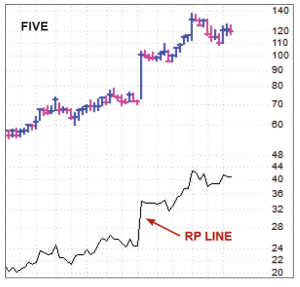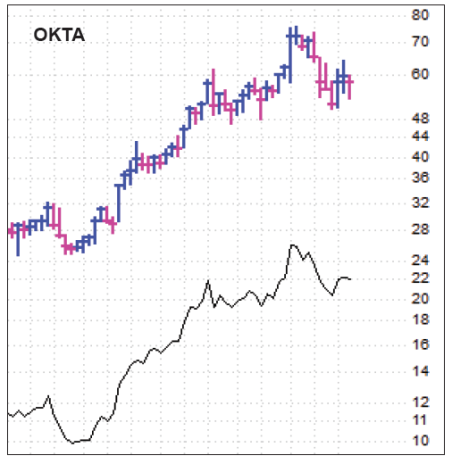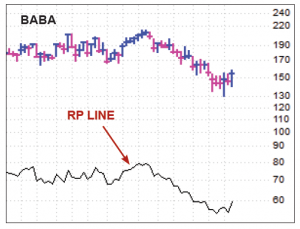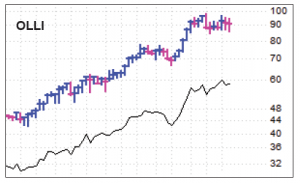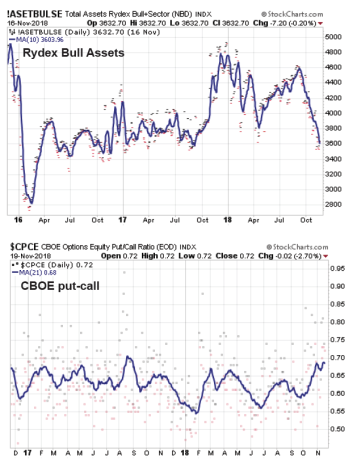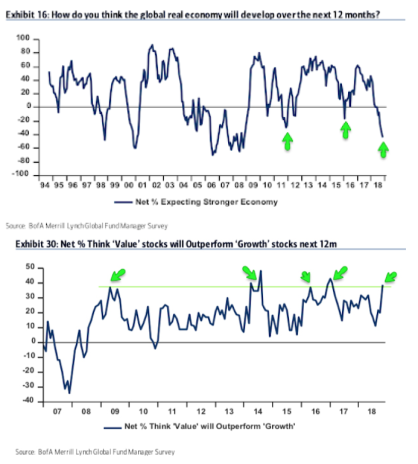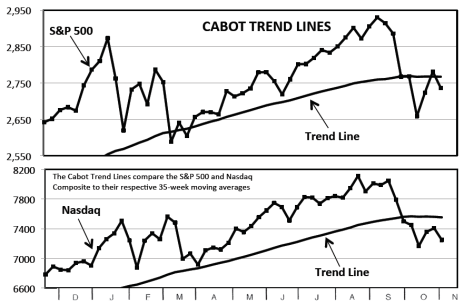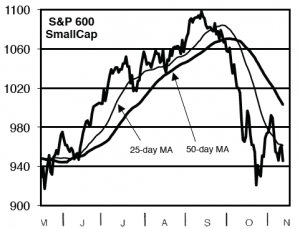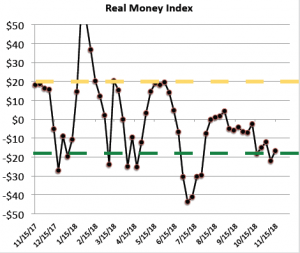The market’s decline has intensified in recent days, driving the Nasdaq back to its October low, hammering most growth stocks and keeping our trend-following indicators firmly bearish. There are a couple of encouraging signs among secondary measures, but until the buyers show up, we advise a defensive stance.
Yesterday, we were forced out of two of our three remaining stocks as they plunged through support. That leaves us with just one position remaining and a huge cash position near 90%. We could put a bit of money to work if the market stabilizes, but tonight we’re sitting tight.
In tonight’s issue, we dive into some sentiment measures which are offering a ray of hope, expand our watch list and write about one type of investment that could be a good way to get a foot in the door of the next uptrend.
Cabot Growth Investor 1407
[premium_html_toc post_id="164603"]
Over the Falls
During the past few weeks, we’ve seen huge up days, crushing down days, dramatic reversals (like today’s), big earnings gaps (up and down) and a slew of big-font headlines ranging from U.S.-China trade rumors, views from Fed members concerning rate hikes, Brexit-related resignations and, of course, the U.S. midterm elections.
But through it all, nothing has really changed when it comes to the two key factors that really count: The trends of the major indexes remain clearly down, and the action of potential leading growth stocks is still abysmal. Indeed, we’ve been at this for a few decades, and we’d rank Monday’s over-the-falls growth stock wipeout as one of the worst we’ve seen, even including some of the worst days of the 2008 bear phase. All told, it means a big cash position remains appropriate.
Still, just as nothing’s changed with respect to having a defensive stance, nothing has changed when it comes to keeping our eyes open for a sustainable low. Believe it or not, a few rays of light are emerging on the sentiment front (see page 6 for more on that) and with the broad market—even as the Nasdaq briefly plunged to new correction lows today, the 400-ish stocks hitting new lows today on that exchange was far fewer than the 561 seen at October’s nadir. (The action of the NYSE broad market isn’t as promising.)
Don’t get us wrong—we’re not whistling past the graveyard or trumpeting sunshine. After getting knocked out of two stocks yesterday, we’re sitting on a massive cash position north of 90%, and while we’d like to put a little of that to work if the market stabilizes, we’re keeping most of the portfolio on the sideline until the two factors mentioned above (market trends, action of leaders) show major improvement.
Instead, our point is that, despite extreme volatility and elevated emotions, it’s vital to keep a level head. Let everyone else make bold predictions about what comes next (bullish or bearish) and react to every headline. Our goal isn’t to predict, but to be ready for the next uptrend, whenever it begins—that is where the real money will be made as a batch of new leaders lifts off and run for six, nine or 12 months as big investors pile in. Until then, it’s best to keep most of your powder dry and patiently wait for the sellers to run out of ammo.
[highlight_box]WHAT TO DO NOW: Remain defensive. Yesterday’s growth stock massacre knocked us out of Okta and Teladoc, leaving us with just one stock (FIVE) in the Model Portfolio and a cash position above 90%. We could put some of that back to work if the market finds its footing, but tonight, we’ll stand pat.[/highlight_box]
Model Portfolio Update
If you’re a salesperson and you get rejected by a couple of potential clients, what are you taught to do? Pick yourself up by the bootstraps and make some more contacts! Same goes if you’re an entrepreneur, scientist, investor, you name it—the message for life in general is if at first you don’t succeed, try, try again. Persistence and optimism will win out in the end.
But like so many things, rules that apply to success in ordinary life often contradict what works in the market—instead of “never giving up,” successful investors give up quickly and frequently and, when the overall environment is against them, mostly sit on their hands instead of forcing trades.
That’s obviously what we’ve been doing in the Model Portfolio during the past few weeks—we haven’t done any new buying in the Model Portfolio since late August (!). We built a 61% cash position as of October 11 that rose to 77% coming into this week and, after yesterday’s sales, is now above 90%, a very rare defensive posture on our part.
Of course, this has been an unusual environment where no matter how much cash you’re holding, it never seems like enough. Even so, given some of the rays of light out there (such as worsening investor sentiment—see page 6), we wouldn’t mind nibbling on a couple of stocks on our watch list if the market stabilizes in the days ahead. The idea would be to take half-sized (5% of the portfolio each) positions in stocks that have already shown signs of bottoming, all while maintaining a defensive stance (75%-plus cash in the portfolio) until our indicators improve.
Speaking of the watch list, most names have been rattled, but we still see a good amount of resilience out there—not a ton of great bases, but solid relative strength. The longer these names can hold up, the greater the chance they can make runs once the pressure comes off the general market.
Current Recommendations
BUY—Five Below (FIVE 104)—One of the traits of severe market selloffs is that the bears tend to “rotate” from group to group over time. Recently, we’ve seen retail stocks take their turn under the gun, prompted by Wal-Mart’s poor earnings reaction last week and talk on their call that tariffs are beginning to bite, followed up by Target’s horrid earnings reaction today (though much of that had to do with Target’s heavy investments). The news items opened the door to many discount retailers getting hit, including FIVE, which gapped to new correction lows, though the stock is still near the top of its prior summertime consolidation. On the subject of tariffs, it’s good to remember that, in its September conference call, Five Below’s management said that the current and proposed tariffs on Chinese goods won’t affect this year’s results; that there’s a possibility that certain items on the tariff list might be taken off as it’s finalized; and that it’s already in talks to get ahead of the levies by changing products, sourcing and pricing. (It also mentioned options such as bumping up the price of certain non-tariffed items by a buck or two in order to mitigate the lower profit from tariffed items.) Of course, in the market, investor perception is vital, so none of this means that FIVE can’t take on more water if the market stays weak and if tariff worries persist. But longer term, we think the odds are strongly against Five Below’s underlying growth story getting dinged from a slowing economy and/or trade tensions. Obviously, if the stock really unravels (there’s major support near 95), we won’t just hold and hope, but despite today’s decline, the stock’s 21%-ish correction isn’t horrible given what’s going on among growth stocks. We’re holding our shares, and are still OK buying a small position here or on dips if you’re not yet in and are holding a large cash position.
SOLD—Okta (OKTA 48)—We’ve been at this game a long time and have lived through some harrowing days for the market, certain sectors and individual stocks. But the action of all cloud software names on Monday was right up there with the worst we’ve ever seen—even the “blue chip” name in the group (Salesforce.com) fell 9%, with many others falling 12% or more. OKTA was no exception, plunging through not just its October low but its long-term 200-day line on a big pickup in volume. Like many stocks, this one is stretched to the downside, so a bounce wouldn’t be surprising. But instead of forming some higher lows while the Nasdaq and growth stocks struggled, OKTA has done the opposite, which, at the very least, tells us it’s unlikely to be a leading stock should the market get off its duff during the next few weeks. Plus, bigger picture, we’re not in the business of holding anything below its 200-day line—we gave the stock plenty of rope, but we were forced to sell on our Special Bulletin last evening. If you still own some and want to try to catch a bounce, that’s fine, but the major trend looks broken.
SOLD—Teladoc (TDOC 55)—TDOC has seemingly been on the edge of getting kicked out of the portfolio for the past three weeks, but each time found support and bounced. That pattern ended on Monday, though, with the stock plunging through its 200-day line and hitting new correction lows. If management continues to execute, this remains such a big and potentially pervasive story that we could easily see the stock rounding out a new launching pad down the road. But we have to deal with the here and now, and with shares clearly below long-term support, and with the stock having started the year around 35, there’s nothing that says this dip can’t get a lot worse before (and if) it gets better. All in all, we gave our partial position every chance to find buyers, but were forced to sell Monday evening. As with OKTA, if you still own some and want to try to sell on a short-term bounce, it’s a fine goal, but big picture we think there will be better stocks to own during the next uptrend.
Watch List
Canada Goose (GOOS 63): GOOS soared on earnings last week and remains in prime position to extend those gains when the market returns to health. We think the growth potential here is huge as the high-end brand expands into new categories. See page 4 for more.
Ciena (CIEN 31): CIEN was downgraded this morning, which, along with the market selloff, dented the stock. But you have to be impressed with how shares are etching higher lows (28 early October, 29 late October, 30.5 today) as the market plunges. Bigger picture, Ciena looks like a leader in the buildout of 5G infrastructure, which we believe could be a favored theme for the next market uptrend.
Etsy (ETSY 43): Like just about every other recent earnings winner, ETSY has given up most of its move in recent days. But stepping back, the stock remains well above its prior lows (42 today vs. 38 in October) and volume has been just so-so on this latest pullback. We still see big potential as Etsy grabs market share in its e-commerce niche.
Exact Sciences (EXAS 65): It’s a similar story with EXAS, which nearly tagged new highs in the days after its earnings report but has since sagged—though it also remains above its October low (62 vs. 59). The valuation is obviously big, but the backing of Pfizer and the non-economically- (or tariff-) sensitive product means there’s little standing in the way of continued rapid growth as Cologuard gains share.
MongoDB (MDB 70): MDB is a wild child, with crazy swings up an down so far this month. But after running from 34 to 85 this year, it’s holding most of those gains. Fundamentally, the firm’s database platform appears to be the next big thing for corporations around the world.
PayPal (PYPL 78): There aren’t many potential liquid leading stocks out there, but we think PYPL—which we got out of near the start of October, thankfully—is one of them. The stock is holding its early October low. See page 5 for more.
ProShares Ultra S&P 500 Fund (SSO 104): As we discuss on page 7, a leveraged long index fund can be a great way to get a foothold in a new market advance without taking the individual stock risk (such as with earnings season). We’ve owned SSO and some others like it before with fine success, and given the magnitude of the current wipeout, it’s a good bet the next sustained uptrend could go far.
Tesla (TSLA 347): TSLA was a rare sight on Monday, briefly hitting three-month highs before the market weighed it down. The skepticism surrounding the company remains very high (30 million shares are still sold short, or about 23% of the float!), but it seems that the stock has found its lows and big investors are looking ahead to big profits (earnings estimates keep rising, now at $6.29 per share for 2019).
Twilio (TWLO 76): On a short-term basis, TWLO is going through the washing machine with other growth stocks, gapping up wildly on earnings earlier this month before plunging on Monday. Maybe the stock will need a deeper, more prolonged correction to set up, but at this point it’s miles above its prior low (72 vs. 62) and we believe this pervasive, accelerating growth story will attract hundreds more big investors over time.
Xilinx (XLNX 85): We won’t say XLNX could be another Nvidia, as that stock (before its recent top) was one of the bigger winners in recent market history. But we’re intrigued by this chipmaker’s focus on newer growth-oriented markets (5G, data centers and more) that have produced accelerating sales and earnings growth and huge free cash flow. The stock is extremely resilient.
Other Stocks of Interest
The stocks below may not be followed in Cabot Growth Investor on a regular basis. They’re intended to present you with ideas for additional investment beyond the Model Portfolio. For our current ratings on these stocks, see Updates on Other Stocks of Interest on the subscriber website or email mike@cabotwealth.com.
Alibaba (BABA 146) — If you know only one Chinese stock, it’s probably Alibaba, the 800-pound gorilla of Chinese e-commerce. With a $379 billion market cap and annual sales of over $47 billion (plus the November 11 Singles Day celebration that generates more sales in a few hours than all of Black Friday in the U.S.), Alibaba has the scale (and free cash flow) to push into cloud operations, original content production, payments, AI, delivery, finance and anything else it wants to. Revenue grew by 65% in 2017 and by 76%, 65% and 49% in the first three quarters of this year. BABA fell from 212 in June to 135 in early October as investors got scared out of China, but it’s been outperforming the U.S. market since then and looks like it’s trying to put in a bottom, as are Chinese stocks in general. It’s not time to buy yet, but keep an eye on it.
Canada Goose (GOOS 63) — Canada Goose made its name when its pricey, high-quality down-filled coats, vests and such caught on in the apparel industry. The business is seasonal, but the sales trends are strong (up 46% in the last fiscal year) and the company is expanding its product line to include knitwear, spring clothing and outdoor performance footwear. GOOS came public in March 2017 and never traded below that price and needed just a few months to consolidate its IPO gains and get moving, hitting 38 last February and 69 in June, following a huge earnings gap up. GOOS took a few months off after that June gap, trading down to 46 (and near its 200-day moving average) during the October market pullback. But another positive earnings report on November 14 gave the stock a more modest gap up to over 70. If management can manage the transition to e-commerce and globalize the brand, the potential here is huge.
PayPal (PYPL 78) — It’s generally not a good sign when a stock is at the same price it was a year ago, but PayPal, which is trading in the high 70s, may be the exception. PayPal, which was spun off from eBay in July 2015, is a leader in online payments, offering secure payment solutions for both consumers and merchants on any platform, including mobile devices and wearables. The company has enjoyed years of double-digit revenue growth and has averaged nearly 29% earnings growth over the last six quarters. The stock, on the other hand, got clobbered in October, falling from 90 to 75, gapping up to 88, and now retesting that October low along with the Nasdaq. What we’re watching is the possibility that all this volatility has reset the stock (we think most of the weak hands are out), and that the next uptrend may reach a broader audience. The setup is there, and when the market strengthens, PYPL should be ready.
Ollie’s Bargain Outlet (OLLI 82) — Ollie’s Bargain Basement is a discount and closeout retailer with 300 stores across 21 states in the eastern U.S. The company, whose motto—Good Stuff Cheap—says all you need to know about its strategy, is a model of consistent revenue and earnings growth, and has one of the market’s best cookie-cutter stories. Customers are very loyal, and with economic tensions high, the company’s strategy seems spot-on for today’s conditions. OLLI made a run from 67 at the beginning of August to 96 at the end of September, then traded sideways through October and most of November. The slip to the low 80s on November 20 has pulled the stock below its multi-month trading range, so you’ll want to wait out this correction. But OLLI is a great addition to your watch list.
Bottoms are Usually a Process, Not an Event
One of the major things we noticed during the October market plunge was that the damage was so severe, so persistent and came so quickly (the Nasdaq fell nearly 15% in just over three weeks, while most growth stocks fell 20% to 30%!) that most investors were stunned. They didn’t have time to turn bearish or panic out of stocks.
That might seem like a non-issue, but in the market, understanding investor psychology is usually more valuable than having an MBA—once a downturn is underway, it rarely ends until we see signs that investors are throwing in the towel. Encouragingly, the last week or two brought a few such signs.
The first was from our Real Money Index (chart on page 8); the initial green light came in mid-October, which was overwhelmed by the market’s crash-like action. But we also saw a move into positive territory two weeks ago as money was generally being yanked from funds.
Another (narrower) money flow measure is showing something similar. The 10-day moving average of assets in Rydex bullish funds has skidded sharply since early September, is now back to its lowest level since August 2017 and isn’t far from breaking to two-and-a-half year lows.
Then there’s the 21-day CBOE equity put-call ratio, which is also at its highest level since last August, and the 10-week average of individual investors (from AAII) that are bearish in their weekly survey is nearing the top of its range from the past three years.
And finally, we have some intriguing longer-term sentiment measures that have reached relatively extreme levels. According to the Bank of the America monthly survey of institutional investors (who in total control more than $600 billion in assets), we saw last week that big investors’ opinion about how the global economy will do going forward is now at its lowest level since 2009.
Second, as you can see in the second chart, the number of managers who believe value stocks will outperform growth during the next year is near its highest level since 2009. Granted, these are opinions, but historically these measures are like most other sentiment gauges—contrary in nature, so when most are leaning one way, the market often surprises in the other direction eventually.
Of course, as we always write, sentiment is a secondary indicator, meaning it doesn’t outweigh the trends of the major indexes and the action of leading growth stocks. And besides, there’s nothing that says some of these readings can’t become even more extreme over time. But after a good amount of complacency despite the crash in October, we’re finally starting to see some investor panic and bearishness appear—that’s a good contrary sign for the market down the road.
Don’t Forget About Leveraged ETFs
In the long run, the big money is going to come by owning leading growth stocks for a big chunk of their multi-month (or multi-year) advances. But that doesn’t mean you have to be a purist about it. In fact, we’re big fans of selectively using leveraged long ETFs to benefit from a new uptrend, and it’s possible we might add one to the Model Portfolio when the time comes.
The ProShares Ultra S&P 500 Fund (SSO) is one we have on our watch list and have owned in the past; it will move twice the percentage of the S&P 500 (give or take) every day, up or down. And while some say that funds like SSO can suffer “tracking error” over many weeks, we’ve studied it and found that it tracks the S&P 500 quite accurately at a 2x rate—maybe a percent or two worse than it “should” perform over many months if there’s a ton of volatility, but no big deal for our purposes.
However, we advise keeping things simple: When we do look for leveraged long funds, we stick to funds that (a) track a major market index, usually either the S&P 500 (SSO), the Nasdaq 100 (QLD) or the Russell 2000 (UWM), and (b) we generally stick with funds that are twice as volatile as the index. In other words, we have no interest in chasing some thinly traded 4x leveraged fund that tracks some sector—you can get into trouble with those.
The bottom line is that, while they’ll never be the core of our portfolio, these leveraged long index funds can prove useful as “get your foot in the door” investments in new market rallies, giving you exposure to a new advance and, if things go well, offering solid gains should a sustained uptrend take hold.
Cabot Market Timing Indicators
The market continues to trend lower and growth stocks are being taken apart. There are some hopeful signs (sentiment, broad market divergences), so you shouldn’t stick your head in the sand, but until the market itself gets moving, you should be holding plenty of cash.
Cabot Trend Lines: Bearish
Our Cabot Trend Lines remain on its sell signal from October 19, as both the S&P 500 (by 1.1% as of last Friday) and Nasdaq (by 4.0%) are stuck below their 35-week lines. As we wrote a month ago when the indicator turned bearish, a sell signal doesn’t always portend a massive decline, but in effect it opens the door to such an occurrence. And that means you should step lightly until the longer-term trend turns back up.
Cabot Tides: Bearish
Our Cabot Tides have been negative since early October, and they remain so today—all five indexes we track are still south of their 25-day lines (like the S&P 600 SmallCap, shown here). That said, we’re keeping our eyes open—if the indexes rally a few days from here, we could actually get a buy signal sometime next week. But the evidence in front of us is what counts, and today, it remains bearish.
Cabot Real Money Index: Neutral
Our Real Money Index has been bouncing in and out of the green zone during the past month, as investors are generally yanking money out of equity mutual exchange traded funds at a good clip. It’s a secondary indicator, but along with some other sentiment measures, it’s painting a picture that investors are running from this market—a small feather in the bull’s cap.
[premium_html_footer]
Send questions or comments to mike@cabotwealth.com.
Cabot Growth Investor • 176 North Street, Post Office Box 2049, Salem, MA 01970 • www.cabotwealth.com
All Cabot Growth Investor’s buy and sell recommendations are made in issues or updates and posted on the Cabot subscribers’ website. Sell recommendations may also be sent to subscribers as special bulletins via email and the recorded telephone hotline. To calculate the performance of the portfolio, Cabot “buys” and “sells” at the midpoint of the high and low prices of the stock on the day following the recommendation. Cabot’s policy is to sell any stock that shows a loss of 20% in a bull market (15% in a bear market) from our original buy price, calculated using the current closing (not intra-day) price. Subscribers should apply loss limits based on their own personal purchase prices.
Charts show both the stock’s recent trading history and its relative performance (RP) line, which shows you how the stock is performing relative to the S&P 500, a broad-based index. In the ideal case, the stock and its RP line advance in unison. Both tools are key in determining whether to hold or sell.
THE NEXT CABOT GROWTH INVESTOR WILL BE PUBLISHED DECEMBER 5, 2018
We appreciate your feedback on this issue. Follow the link below to complete our subscriber satisfaction survey: Go to: www.surveymonkey.com/marketlettersurvey
Neither Cabot Wealth Network nor our employees are compensated by the companies we recommend. Sources of information are believed to be reliable, but are in no way guaranteed to be complete or without error. Recommendations, opinions or suggestions are given with the understanding that subscribers acting on the information assume all risks. © Cabot Wealth Network. Copying and/or electronic transmission of this report is a violation of U.S. copyright law. For the protection of our subscribers, if copyright laws are violated, the subscription will be terminated. To subscribe or for information on our privacy policy, call 978-745-5532, visit www.cabotwealth.com or write to support@cabotwealth.com.
[/premium_html_footer]



